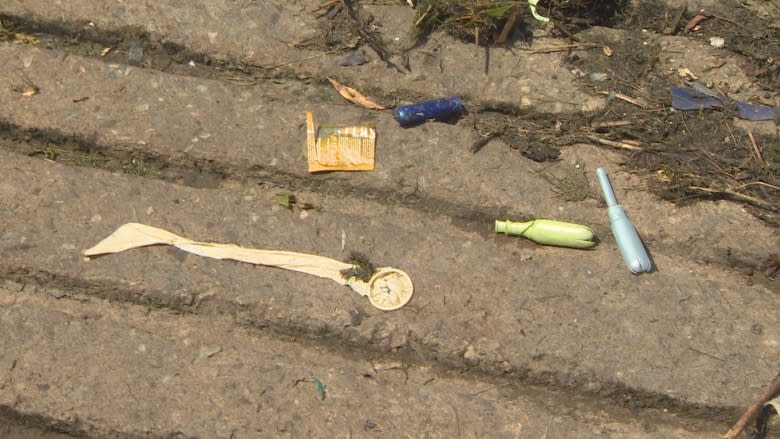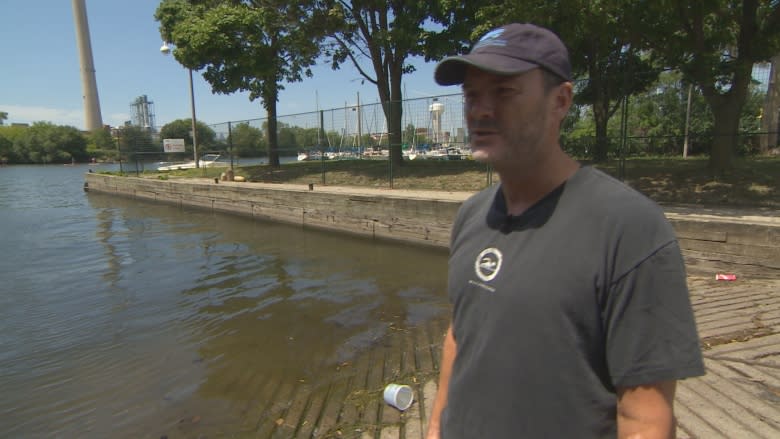Condoms, tampons found in Lake Ontario, city unsure of source
A Lake Ontario conservation group is calling on the city, and city residents, to do more to keep the lake clean after it found a two-kilometre-long stretch of garbage off of Ashbridges Bay.
Earlier this month, Mark Matson of Lake Ontario Waterkeeper was driving the group's boat, the Angus Bruce, from Cobourg to the GTA when he and his crew spotted the stream of condoms, tampons, wet naps and other trash floating on the water.
Matson said the items and the large swath of trash suggest it all came from the city's sewage system. However, the city said it has not had a sewage bypass since January, and suggested it came from another source, such as illegal dumping or cross-border pollution.
No one from the city was available to further discuss the issue on camera.
Matson reported the garbage to the city and to Ontario's Ministry of the Environment. He said it's difficult to get anyone to take ownership and clean it up.
So he's asking residents to report any garbage on the water to the city and the province, so they have a record.
"The people of the city have to demand it," Matson told CBC News when asked what it will take for the city to take action.
"They have to reacquaint themselves to this lake. They have to get involved again, report when they see pollution, use the lake, go boating and go swimming and understand that this is the future of Toronto."
'No water-quality data'
The city tests about three per cent of the waterfront, according to Matson, areas that include the beaches that it declares fit for recreational use. That leaves 97 per cent of the waterfront untested, he said.
Matson showed off garbage near the Ashbridges Bay boat launch, noting that kids were swimming and stand-up paddle-boarders were paddling nearby.
"There's no water-quality data from the city in this area, and clearly there's a demand for it and a need for it," he said.
Matson's group took water samples to test that part of the lake for E. coli.
"The fact that it's not a beach doesn't mean that it shouldn't be monitored," Matson said. "There are people here stand-up paddle-boarding, rowing, surfing out front and this area needs to have clear water quality monitoring to let them know the risks that are in their water."
While Matson discovered the garbage out on the water, he said it can easily make its way up onto the city's beaches.
"They are in and of themselves not a threat for swimming, although it would scare most people I know out of the water if they came out with a condom on their head," Matson said.
"But what I think is important is to let people know, though, that Lake Ontario is an amazingly clean lake, it's swimmable…but what we put in on a day-to-day basis through our negligence and through our sewage and storm water is what keeps people away."
'Simply horrified'
Someone else who was horrified to learn of the line of garbage was Marilyn Bell DiLascio, who, at age 16, became the first person to swim across Lake Ontario.
"I am simply horrified by this discovery and the current health of our beautiful lake," Bell DiLascio wrote in a letter posted to Lake Ontario Waterkeeper's website.
"During my time swimming in Lake Ontario in the 40s and 50s, where I swam as a child and later trained as a marathon swimmer, water quality was never an issue. But today those same places where I swam in are no longer welcoming to my children and grandchildren."
She called on civic leaders "to look at the long-term effects of this situation now in order to ensure we are leaving the lake in a healthy state for the future generations of Canadians."



